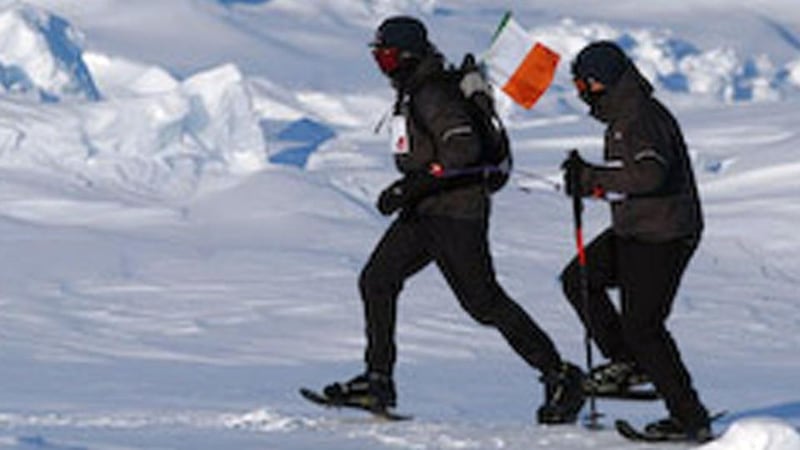Being blind and paralysed from the waist down has not stopped Mark Pollock from achieving more in his 38 years than most fully able-bodied people do in a lifetime. And this remarkable man from Co Down is now at the forefront of the international search for a cure for spinal cord injury.
At age five, Pollock lost the sight in one eye. Then, at age 22, on the rowing team at TCD while studying Business and Economics, he lost the sight in his other eye, making him fully blind. Ten years later, Pollock became the first blind person to race to the South Pole – one of a hefty list of adventures which included an ultra endurance six marathons in six days across the Gobi desert.
His success helped him to move on with his life and he became engaged to his girlfriend Simone George. However, only four weeks before their wedding in 2010, he broke his back in a devastating 25-foot fall from a second-storey window while attending the Henley Regatta.

He says he cried every day for the first three months after being told he was paralysed from the waist down, and every second day for the next three months. Then the incredibly determined adventure athlete and motivational speaker picked himself back up and, with George at his side every step of the way, started fighting back.
In 2009, one year before he broke his back, Pollock had followed in Ernest Shackleton’s tracks across the Antarctic ice. This is not the only parallel between him and the famous explorer. Last year he attended the World Economic Forum’s group of Young Global Leaders (YGL) for a course on leadership in extreme situations, led by Harvard University professor Herman “Dutch” Leonard.
Epiphany
Leonard’s research into how Shackleton and others solved unpredictable problems was an epiphany for Pollack and inspired him to seek a solution for his own predicament by finding and connecting brilliant minds worldwide to fast-track a cure for spinal injury, with help from the Mark Pollock Trust, started by his friends.
“When people think about what a cure might look like, they almost always think about the obvious lack of movement and feeling. But spinal cord injury strikes at the very heart of what it means to be human; an evolutionary amputation completed in a moment, turning us from our standing upright, running forms into seated compromises of our former selves. It results in a loss of sexual function and the ability to have a family without IVF. We lose normal bladder and bowel function and have to live and work with the constant management of this on our minds. We lose connections to the brain which interfere with the things that keep us alive and we die before our time.”
Pollock sees himself as a pioneer exploring the exciting new frontiers of spinal cord injury recovery. Through the YGL community, he was introduced to the Christopher and Dana Reeve Foundation leadership and in turn to University of California Los Angeles scientist Dr Reggie Edgerton.
He has been working with Dr Edgerton on an experiment to walk his paralysed legs using a combination of robotic legs, electrical stimulation of his spinal cord and medication. Being part of this group has opened up a whole network of people across the world who are hugely ambitious in their efforts to find a cure for paralysis. In turn, he has offered his body and his robotic exoskeleton to UCLA for research.
Robotic exoskeleton
The study is the first of its kind. As Pollock walked for extended periods in his robotic exoskeleton, a team of scientists tracked what was going on, if anything, in his paralysed legs. Their primary objective was to determine whether they could improve his posture and stepping by using two novel ways to neuromodulate (excite and affect) the spinal cord. Although the data is still being analysed, Pollock is able to say that he has felt the impact of the interventions.
“I am as physically fit as a paralysed person can be. I have become the leading test pilot for pioneering robotic legs from Ekso Bionics. I roll to the gym every day in my wheelchair and I strap my paralysed limbs into robotic legs and I walk miles and miles of steps. When I shift my weight, it activates sensors in the robotic legs, which then initiate the steps, helped by battery-powered motors.
“I have walked more than anyone else, more than 400,000 steps in my robot. Although there is no proof yet that walking in the robot will restore function to my damaged spinal cord, doing it has put me in a position to work with those who are starting to understand how to do so.”
Pollock is optimistic of a cure for spinal injury in his lifetime, but he is also keenly aware that, so far, the search for a cure has met with failure.
“In my mind, these brilliant people we have started to meet are the same as the geographical explorers of 100 years ago. The problem is 100 per cent unsolved right now but there are flashes of potential and possibility around the edges which keep everybody going.”
The cure will, Pollock believes, involve a cocktail of therapies including physical therapy, robotics, electrical stimulation and drugs and will require collaboration across geographical, organisational and intellectual boundaries.
Unbreakable, a new film that tells Pollock's story, will have school screenings during Science Week and will also be previewed in cinemas around the country. See markpollockfilm.com/screenings/ The Life Style Sports Run in the Dark challenge will take place on Wednesday, November 12th, to support the Mark Pollock Trust. Five- and 10-kilometre fundraising runs will be held in 30 cities worldwide including Dublin, Cork and Belfast. See runinthedark.org











